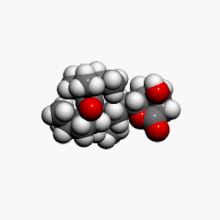Scandinavian Simvastatin Survival Study
| Scandinavian Simvastatin Survival Study | |
|---|---|
 Simvastatin 3D | |
| Type of project | Multicenter clinical trial |
| Country | Scandinavian countries |
| Established | 1990s |
| Disestablished | 1990s |
| Funding | Merck |
| Status | Completed |
The Scandinavian Simvastatin Survival Study (also known as the 4S study), was a multicentre,
Before the 4S study, it was not proven that lowering cholesterol could prolong life in people who had CHD.
Objective
The 4S multicentre, randomized, double-blind, placebo-controlled clinical trial enrolled 4,444 people chosen from 7,027 people who had been followed up for two months after being given dietary advice.[2] The objective of the study was to assess the effect of a cholesterol-lowering drug called simvastatin on mortality and morbidity in people with a history of a previous heart attack or angina, who also had a moderately raised cholesterol; between 5.5 and 8.0 mmol/L.[1][5][6]
A second objective was to investigate whether the incidence of major coronary artery disease events (fatal and nonfatal myocardial infarction and sudden death) could be reduced with simvastatin.[2]
Study details
The participants, all at high risk of death from CHD and death in general,[5] were selected from 94 clinical centers in Denmark, Finland, Iceland, Norway, and Sweden from 1988 to 1989, and were aged between 35 and 70 years, with the average age being 59.[2][7] Of the 4,444 people enrolled in the study, 3,617 were men and 827 women,[5] 2,223 were randomly assigned a placebo and 2,221 were given 20 to 40 mg of simvastatin daily.[1] The plan was to follow the participants for a minimum of three years or until such a time as total mortality reached 440 deaths.[2][5] In practice, the study carried for a median period of 5.4 years.[3]
Results

After 5.4 years, compared to the group that were given placebo, the simvastatin group demonstrated a 35% reduction in
A follow-up of treatment with simvastatin for up to eight years was published in 2000.[7] Ten years after the start of the 4S trial, a follow-up study published on 28 August 2004 in The Lancet, revealed that of those 2,221 people who continued to take simvastatin, there was a further reduction in number of deaths from CHD when compared to those who had switched from placebo to statin at the five year mark.[7][10] The overall mortality also reduced by 15% at the 10 year mark.[3][7]
Conclusion
The study concluded that
Response
Published in The Lancet in 1994, the 4S trial, had an immediate influence on medical opinion,[9] and is considered a "landmark paper".[3][4][11] Several other large multicenter clinical trials followed, leading to widespread use of simvastatin.[3]
Data from the 4S trial has frequently been used to analyse the cost-effectiveness of simvastatin in secondary prevention.[12][13]
See also
- Heart Protection Study
- HDL-Atherosclerosis Treatment Study
- West of Scotland Coronary Prevention Study
- Pravastatin or atorvastatin evaluation and infection therapy - thrombolysis in myocardial infarction 22
References
- ^ ISBN 1-57340-221-4.
- ^ PMID 8430625.
- ^ ISBN 978-0-19-959476-4.
- ^ ISBN 978-085484-107-3.
- ^ ISBN 978-94-010-0794-8.
- ^ PMID 10922429.
- ^ "Atheroma". Scientific Animations. Retrieved 7 April 2020.
- ^ PMID 19042967.
- ^ Wood, Shelley (27 August 2004). "Ten-year outcomes from 4S study". Medscape. Retrieved 2 April 2020.
- ISBN 978-0-323-32195-2.
- ISBN 978-0-7817-7012-5.
- PMID 8809516.
Further reading
- Baigent C, Blackwell L, Emberson J, Holland LE, Reith C, Bhala N, Peto R, Barnes EH, Keech A, Simes J, Collins R (2010). "Efficacy and safety of more intensive lowering of LDL cholesterol: a meta-analysis of data from 170,000 participants in 26 randomised trials". Lancet. 376 (9753): 1670–81. PMID 21067804.
